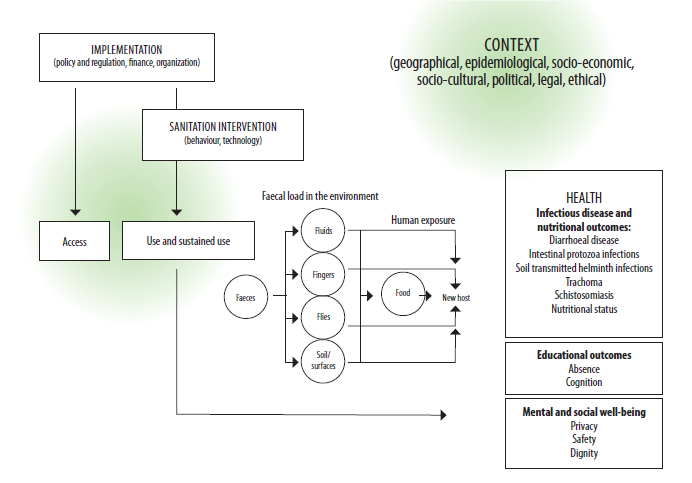- Forum
- categories
- Health and hygiene, schools and other non-household settings
- Health issues and connections with sanitation
- Global guidelines on sanitation and health (WHO, 19 Nov - 18 Dec 2018, Thematic Discussion 13)
- Theme 1 - Evidence on sanitation and health
- What does the evidence on sanitation and health tell us? What does it mean for practitionners?
What does the evidence on sanitation and health tell us? What does it mean for practitionners?
7304 views
- sboisson
-
 Topic Author
Topic Author- Technical officer, Water, Sanitation, Hygiene and Health Unit, WHO
Less- Posts: 17
- Likes received: 12
Re: What does the evidence on sanitation and health tell us? What does it mean for practitionners?
A Faecal Contamination Index for interpreting heterogeneous diarrhoea impacts of water, sanitation and hygiene interventions and overall, regional and country estimates of community sanitation coverage with a focus on low- and middle-income countries (2018) Wolf J, Johnston R, Hunter P, gordon B, Medlicott K, Pruss-Ustun A
"Highlights
• An index for estimating faecal contamination in the community is proposed that combines a broad set of WASH indicators.
• Faecal community contamination is an important determinant of a sanitation intervention's effectiveness to reduce diarrhoea.
• Above a certain level of faecal contamination, interventions are less likely to lead to reductions of diarrhoea.
• Less than half of the global population lives in communities in which coverage with basic sanitation services exceeds 75%."
Please Log in to join the conversation.
You need to login to reply- sboisson
-
 Topic Author
Topic Author- Technical officer, Water, Sanitation, Hygiene and Health Unit, WHO
Less- Posts: 17
- Likes received: 12
Re: What does the evidence on sanitation and health tell us? What does it mean for practitionners?
We have not yet considered developing a database like eLENA but this is a great suggestion and I will be meeting our nutrition colleagues to learn more about their experience with it.
I think asking key questions (although these may not always be so simple!) on implementation would be an important starting point. As you suggest, looking at survey data like DHS and MICS can also be very useful for highlighting patterns and trends, exploring associations and generating hypotheses.
Kind regards,
Sophie
Please Log in to join the conversation.
You need to login to reply- oh
-
Less
- Posts: 2
- Likes received: 0
Re: What does the evidence on sanitation and health tell us? What does it mean for practitionners?
I have seen that you already have many features of the eLENA concept in your evidence paper. This made me think that a website based collection of WASH actions (like eLENA is providing for nutrition) could be started to be developed and my question/suggestion is whether you are planning to use your current paper to start developing such a website which could be enlarged whenever new evidence evolves.
I still think that WASH activities are so important for dignified life in good health that it deserves a webpage like that even if we don't have strong evidence for all actions. We might also need to start thinking about research which is asking more simple questions and not only attempt the big ones currently asked (e.g. about disease impact and nutrition outcomes). Another idea might be to take large data sets and look for evidence there, e.g. search survey data (e.g. DHS or MICS data) to understand WASH infrastructure and behaviour patterns and how these are best summarised and used to describe e.g. (the potential for the) spread of disease.
Best wishes,
Dr. Oliver Hoffmann
Public Health Advisor,
Johanniter Germany
Please Log in to join the conversation.
You need to login to reply- sboisson
-
 Topic Author
Topic Author- Technical officer, Water, Sanitation, Hygiene and Health Unit, WHO
Less- Posts: 17
- Likes received: 12
Re: What does the evidence on sanitation and health tell us? What does it mean for practitionners?
www.who.int/water_sanitation_health/sani...ation-guidelines/en/
Please Log in to join the conversation.
You need to login to reply- sboisson
-
 Topic Author
Topic Author- Technical officer, Water, Sanitation, Hygiene and Health Unit, WHO
Less- Posts: 17
- Likes received: 12
Re: What does the evidence on sanitation and health tell us? What does it mean for practitionners?
Thanks for raising these interesting points about the challenges in assessing health impacts of sanitation. The overall body of evidence suggests sanitation has a positive impact on infectious disease, nutrition outcomes and well-being in both rural and urban settings, but we see a lot of heterogeneity in results. Figure 7.1. illustrates well the complexity of the causal chain and why we may see large differences in effect, sometimes no effect at all.
It is true that sanitation interventions are complex - including technologies and behaviours and involving policies, regulations, financing etc. for their implementation. The way these interventions impact disease requires many intermediate steps and highly depends on context e.g. setting, population density, pathogens circulating in the environment, ambient disease levels among the population, dominant exposure routes.
One reason we don't see an impact may be that the intervention fails to significantly reduce pathogen transmission. For example, if the intervention doesn’t reach sufficiently high levels of coverage and use of safe toilets among the community. The review by Garn et al. found that among the 36 studies looking at household sanitation, overall, the intervention led to 14% increase in toilet coverage and 13% increase in toilet use. The review by Sclar et al. found limited evidence of an impact on indicators of faecal exposure. More studies are now showing that disease reduction will not be detected unless coverage and use in the entire community is high as households who have toilets remain exposed to pathogens if other households continue polluting their environment.
Failure to reduce pathogen exposure may be because the type of intervention is not suitable for a given context, not designed properly or not delivered as intended. However, too few studies document interventions delivery and how sanitation affects intermediate outcomes on the causal chain (e.g coverage and use, faecal load in the environment, pathogen transmission). Doing more research in these areas would help inform how we can design and deliver better sanitation interventions in the future. You can find more details on research needs in chapter 8.
Kind regards,
Sophie
Attachments:
-
 Figure7.1....1-24.png
(Filesize: 77KB)
Figure7.1....1-24.png
(Filesize: 77KB)
Please Log in to join the conversation.
You need to login to replyRe: What does the evidence on sanitation and health tell us? What does it mean for practitionners?
sboisson wrote: However, the quality of the evidence was low (which is common in research on complex interventions like sanitation), and we found a lot of heterogeneity in results with studies showing no or little impact on health. Most recently, trials like WASH B and SHINE have failed to show an impact on key health outcomes.
I suspect that ultimately this boils down to a bias inherent in the research methodology. A toilet isn't a medication you can subscribe and measure the effect ceteris paribus.
A sanitation system is also least effective in a "simple" setting that can be easily broken down and confounding factors ruled out, i.e. a setting a researcher will look for to get a "clean" result. What I mean is, that most scientific research has looked to find long running simple sanitation projects in rural settings with a nice control group in a neighbouring village etc. And those research projects that didn't usually do not end up in meta studies or get assigned a low confidence due to "problems" with the study setup etc.
Yet this neglects the larger picture, which is that in such "rural" settings the purpose of a sanitation system is often questionable due to low population density, large quantities of livestock living in direct contact with the study subjects and a typically completely different habitual behaviour in regards to hygiene compared to comparatively more urban inhabitants.
Sanitation is ultimately an urban intervention that is an enabler for higher population densities that strongly interacts with other human habitat interventions.sboisson wrote: What do these research findings mean for sanitation policy and practice?
Not sure to be honest, as trying to do publishable research in an inherently messy urban setup (or a huge densely populated refugee camp) is next to impossible.sboisson wrote: What can be done in future research to better inform sanitation efforts?
Please Log in to join the conversation.
You need to login to reply- oh
-
Less
- Posts: 2
- Likes received: 0
Re: What does the evidence on sanitation and health tell us? What does it mean for practitionners?
www.who.int/elena/about/en/
with an A-Z list of interventions being a single point of reference for the latest nutrition guidelines, recommendations and related information such as available scientific evidence supporting the Guidelines.
Are you planning something similar?
That would be great. Thank you.
Please Log in to join the conversation.
You need to login to replyRe: What does the evidence on sanitation and health tell us? What does it mean for practitionners?
The evidence you’ll find in Chapter 8 was distilled from 14 systematic review on evidence covering each step of the sanitation and health theory of change (fig 7.1) - access and use, effectiveness of behavior change interventions, leakage along the sanitation chain, impact on transmission pathways and a wide range of infectious diseases, conditions cause by infection (e.g. stunting) and wellbeing outcomes.
In chapter 8 you’ll find a summary of what the reviews found on each of these steps and health outcomes.
Water Sanitation Hygiene and Health Unit
Department of Public Health and Environment
World Health Organization
Geneva, Switzerland
Please Log in to join the conversation.
You need to login to reply- sboisson
-
 Topic Author
Topic Author- Technical officer, Water, Sanitation, Hygiene and Health Unit, WHO
Less- Posts: 17
- Likes received: 12
What does the evidence on sanitation and health tell us? What does it mean for practitionners?
To inform recommendations and practical guidance in the guidelines, we went through a rigorous process to look at the evidence on the effectiveness and implementation of sanitation interventions. This included systematic reviews of more than 1000 studies on sanitation-related health outcomes as well as reviews on implementation factors, adoption and use of sanitation facilities, and indicators of faecal exposure.
You will find a summary of the evidence as well as identified research gaps in Chapters 8 and 9 of the guidelines.
The evidence reviews confirmed that sanitation has a positive impact on infectious diseases, nutrition and well-being. However, the quality of the evidence was low (which is common in research on complex interventions like sanitation), and we found a lot of heterogeneity in results with studies showing no or little impact on health. Most recently, robust trials have failed to show an impact on key health outcomes.
We would like to kick off the discussion with the following questions:
What do these research findings mean for sanitation policy and practice?
What can be done in future research to better inform sanitation efforts?
Looking forward to your comments!
Please Log in to join the conversation.
You need to login to reply- Forum
- categories
- Health and hygiene, schools and other non-household settings
- Health issues and connections with sanitation
- Global guidelines on sanitation and health (WHO, 19 Nov - 18 Dec 2018, Thematic Discussion 13)
- Theme 1 - Evidence on sanitation and health
- What does the evidence on sanitation and health tell us? What does it mean for practitionners?








